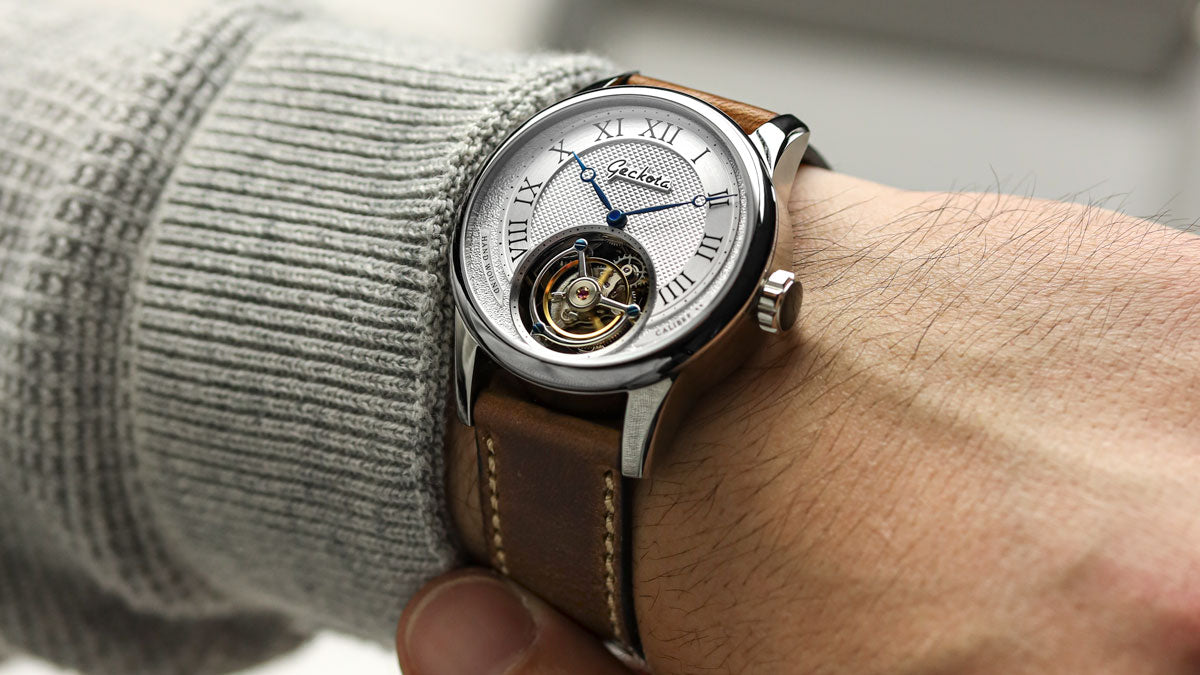
December 11, 2023 4 min read
Call it the biasness of a watchmaker, but there’s something truly enchanting about a hand wound watch. Is it the intricate dance of gears and springs? The hands-on approach to the daily winding ritual? Or simply the knowledge of the exquisite craftsmanship that goes into these timepieces? Whichever it is, no other piece of wristwear evokes a sense of nostalgia and appreciation for the artistry of horology like the manual winding watch.
If you’re new to the world of horology, or maybe a seasoned collector just looking to brush up on your timekeeping trivia, we’re here to uncover all the hidden secrets on hand wound watches. We’ll explain exactly what makes the manual winding watch tick and how best to take care of them.
 GECKOTA TOURBILLON HAND WOUND WATCH
GECKOTA TOURBILLON HAND WOUND WATCH
Hand wound watches, also known as manual-winding watches are a type of mechanical watch that relies on human intervention to keep it running. Unlike modern quartz watches that are powered by a battery, hand wound watches comprise of several intricate components including a mainspring which must be wound up to power the functions on the dial.
To wind the mainspring, you must pull out the crown (typically on the right-hand side of the case) and turn it clockwise. It usually takes only a few turns of the crown to power up the watch, and once you feel resistance from the crown you know that the watch is fully wound. How long your manual winding watch stays powered for after being fully wound depends on the watch’s power reserve. Think of the power reserve as the watch’s gas tank. Most hand-wound watches have a power reserve of around 38-42 hours.
 FORZO DRIVE KING MECHANICAL CHRONOGRAPH SS-B01-B
FORZO DRIVE KING MECHANICAL CHRONOGRAPH SS-B01-B
A common question asked by newbies in the watch world is “what is the difference between automatic and hand wound watches?” While quartz watches are battery-powered, both automatic and manual winding watches are known as “mechanical watches” and are fuelled by hundreds of tiny components. They’re completely autonomous and have no need for electric power sources.
Hand wound and automatic watches differ in how they are wound – a clue is in their names! Manual winding watches must be manually wound by hand by turning the crown. Automatic watches, on the other hand, are equipped with an additional component called the oscillating rotor. This rotor spins inside the case with every movement of the wearer’s wrist.
For the hands, date and other complications of a manual winding watch to work, the movement must first be wound. On the side of the watch case, a small knob known as the winding crown will allow you to wind up a component called the mainspring. The mainspring is the heart of a hand-wound watch and with every turn of the crown, the coiled spring gets tighter. When released, the force of the mainspring turns a series of gears and wheels which are connected to the dial and hands.
 GECKOTA TOURBILLON HAND WOUND WATCH
GECKOTA TOURBILLON HAND WOUND WATCH
Anyone with a love of mechanical timekeeping will enjoy wearing a manual winding watch. Those who wear their watches almost every day often prefer automatic watches, since there’s no need to stop and manually wind the watch themselves. However, there are a dedicated following of individuals that appreciate the craftsmanship and heritage of a manual winding watch.
Those with a deep interest in the art and science of watchmaking often gravitate toward hand-wound watches. They appreciate the mechanical complexity and precision engineering that goes into creating these charming devices. Lovers of vintage watches also tend to lean towards hand wound watches since manual winding watches were the first wrist-based timekeepers in the world. There’s also something charming about the ritual of daily winding and the tactile connection between the wearer and their watch.
 FORZO DRIVE KING MECHANICAL CHRONOGRAPH SS-B01-B
FORZO DRIVE KING MECHANICAL CHRONOGRAPH SS-B01-B
The frequency of servicing a hand wound watch can vary depending on several factors, such as how often the watch is worn and its age. However, as a general guideline, most movement manufacturers suggest servicing a manual winding watch every 3 to 5 years.
Older hand-wound watches may need more frequent servicing, especially if your model is a vintage timepiece. Exposure to extreme temperatures and harsh conditions can also impact the performance of your watch and those with more complex functions, like chronograph and perpetual calendars, may also require more regular servicing due to their complicated mechanisms. It’s always advised to check with the watch’s manufacturer for guidelines on servicing.
So, there you have it, all you need to know about hand wound watches. Has this tempted you to buy a manual winding watch for yourself like our Geckota Tourbillon? Or do you already own one? If so, let us know your favourites in the comments below.

About the Author: Jon Quinn
About the Author: Jon Quinn
I’m Jonathan Quinn, founder and owner of Geckota. What excites me is what excited me when I started the business – offering high-quality watches and straps that I couldn’t find elsewhere, and seeing the pleasure they give our customers around the world.
More Articles by Jon Quinn